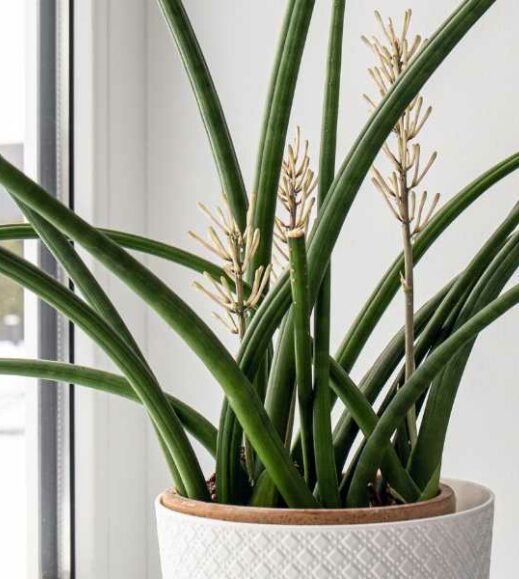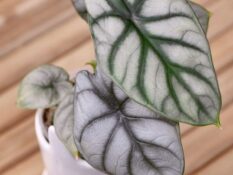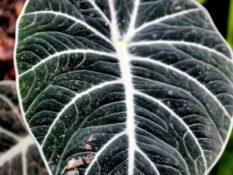Propagate | Soil | Light | Water | Temperature | Humidity | Potting | Pruning | Fertilize | Pest Control | FAQs
The African spear plant is a unique and fascinating flowering plant native to central Africa. With its tall, cylindrical stalks and bright green leaves, this striking plant stands out in any garden.
Despite its exotic appearance, the African spear plant is
easy to grow and care for. It thrives in warm, humid climates, and requires little maintenance beyond regular watering and fertilizing.
With its showy flowers and lush foliage, the African spear plant is an excellent addition to any garden. Whether you are a novice gardener or a seasoned horticulturist, this striking plant is sure to be a hit in your landscape. This guide will answer all common questions about growing, caring for, and maintaining African spear plant plants.
Do African spear plant flower? What color is the African spear plant flower?
Yes, the African spear plant flower can range in color from bright yellow to vibrant orange. The flowers are generally quite large and appear abundant throughout the growing season. They bloom at the top of the plant's tall stalks, creating a stunning display that will catch any passerby's eye.
When to plant African spear plant?
The best time to plant African spear plants is during the spring or early summer when the weather has warmed up, and there is plenty of sunshine. You should avoid planting them in the fall or winter, as they are not very cold hardy and may not survive if subjected to freezing temperatures.
Types of African spear plant: what are the recommended varieties of African spear plant plants?
Several African spear plant varieties include 'Red Edge', 'Futura Robusta', and 'Wagneriana'. Each variety has its unique characteristics and growing requirements. For example, the 'Futura Robusta' variety is more compact than other types of African spear plant, making it an ideal choice for small gardens or containers.
African spear plant soil requirements: What is the best soil for the African spear plant plants?
The African spear plant does best in well-draining, sandy soil rich in organic matter. It would help if you avoided heavy, clay soils or those with a high pH level, as these conditions can be detrimental to the health of your African spear plants. An acidic soil pH of 6.0-6.5 is ideal for optimal growth and development.
Make sure to use healthy soil that is free of disease. Adding amendments and enhancers to the soil can help improve plant growth.
African spear plant light requirements: How much light does African spear plant need?
The African spear plant is a sun-loving, light-requiring plant that prefers bright, indirect sunlight. Ideally, you should place your plants in an area that receives at least 6-8 hours of sunlight daily. If you are growing African spear plants indoors, place them near a sunny window and rotate them regularly to ensure even growth.
If you're looking to help your plants grow better under low light conditions, using plant grow light designed for specific plant wavelengths can improve growth.
African spear plant water requirements: How often to water the African spear plant?
The African spear plant is a relatively low-maintenance plant that only requires occasional watering to thrive. It would be best if you watered your plants regularly, ensuring the soil is never completely dry. However, it's important to avoid over-watering, as this can lead to root rot and other serious problems.
If you're looking for ways to improve soil water retention and increase nutrient delivery, adding a layer of mulch to the top of the soil can help.
The frequency of watering depends on the season and the specific environment. To water your plants most effectively, choose an irrigation system that suits their needs.
African spear plant temperature range: What temperature can African spear plant tolerate?
The African spear plant is a hardy, versatile plant that can tolerate a wide range of temperatures. However, it prefers warm, dry conditions and can't handle excessive heat or humidity. If you're growing African spear plants in an area with high temperatures or a lot of moisture, provide them with plenty of shade and ventilation to help prevent overheating.
If you're looking for ways to keep your plants cool and hydrated during the hot summer months, consider planting them around larger trees or using a shade cloth to provide some relief from the sun.
Be sure to take measures to protect plants during bad weather. You can use a greenhouse, cold frame, and plant protective covers to create a protected environment for your plant that will help keep it healthy and happy year-round.
African spear plant humidity: Do African spear plant like humidity?
While the African spear plant does prefer warm and dry conditions, it does not like humidity. High humidity can cause problems for your plants, including fungal diseases and rot. If you live in a humid climate, you should create a dry environment for your African spear plants.
Several products help maintain the humidity of plants around your African spear plant, including plant misters, and plant pots with built-in reservoirs. Just be sure to choose a product that best suits your plants and their needs.
Where to buy African spear plant?
African spear plant plants can be found at many nurseries and garden centers. You can also order them online from a variety of online retailers. When looking for planting materials, look for plants that are healthy and free of pests or diseases. Always inspect the roots before purchasing your plant, and avoid any signs of rot or decay. Do your research beforehand to find reputable sellers with high-quality planting materials.
African spear plant propagation: How to propagate African spear plant?
Propagating plants is the process of creating new plants from existing ones. It's a great way to propagate your favorite varieties or save money by producing new plants for free. Several methods to propagate your African spear plant include cuttings, divisions, and taking root cuttings.
Propagate African spear plant from root cutting
You'll need a sharp knife or pruning shears to propagate your African spear plant from a root cutting. Start by digging up the root clump, then cut a section of the root with at least 1-2 sets of growth. Set the cutting aside in a warm, moist area to allow it to begin new root growth.
Propagating African spear plant by stem cutting
African spear plants can also be propagated by stem cuttings. To do this, cut a section of the plant with at least 3-4 sets of leaves, and set it aside in a warm, moist environment to grow new roots.
To help increase your chances of success, you can also use rooting hormone or a rooting medium to help your cuttings take root. Just be sure to keep the soil moist and provide plenty of light to promote new root growth and healthy, strong plants.
Propagating African spear plant by division
African spear plants can also be propagated by division. This involves separating the plant into smaller pieces, which can then be re-planted to form new plants. To do this, dig up the plant and divide it into smaller sections using a sharp knife or pruning shears. Once you've divided your plant, replant the sections and keep them well-watered until new roots have formed.
When done properly, these methods of propagating Amazonian elephant's ear plants are quick and effective ways to produce new plants from old ones. Make sure you choose the right time of year and always start with good quality and healthy planting materials.
Potting African spear plant plant
African spear plant plants are also well-suited for container growing. When planted in containers, African spear plants can easily be moved to a different location or brought indoors for the winter. They are also ideal for small garden spaces or patio gardens, where space may be limited.
To pot your African spear plant, choose a container at least 12-18 inches wide and deep. You'll also need potting soil high in organic matter and well-draining. To plant your African spear plant, add the soil to your container and make a small hole in the center of the pot. Place your plant in the hole, and gently firm down the soil around the roots to hold it in place.
To keep your African spear plant healthy and happy, provide plenty of sunlight, and water regularly, and feed with a high-quality organic fertilizer. You can also incorporate other plants into the pot, such as annuals or flowering perennials, to help create a lovely garden display. With the right care and attention, your African spear plant will thrive in its container garden for years.
It is important to select the correct pot size or container for your African spear plant ear plant, as the container's size will significantly impact its growth and overall health. For best results, look for a container with ample drainage holes at the bottom and deep enough to accommodate the full size of your plant's root system.
How to prune African spear plant?
Pruning is an essential part of gardening, as it helps to maintain the health and shape of your plants. There are various pruning tools on the market, including pruners, loppers, saws, and pruning shears. This will help you avoid damaging the plant and reduce the risk of disease or pests.
When it comes to pruning African spear plants, there are a few tips that you should keep in mind. First, prune your African spear plants regularly, promoting healthy growth and preventing the plant from becoming overgrown or leggy. You should also avoid pruning in the hot summer months, as this can seriously stress your plants and make them more susceptible to disease.
If you notice any dead or diseased branches, you should remove them right away. For healthy pruning, always make clean cuts directly above a bud or leaf node to encourage new growth. Additionally, you can use pruning to shape your African spear plant into a column or tree-like shape for a dramatic garden display.
How to fertilize African spear plant?
One of the most important aspects of caring for your African spear plant is feeding it regularly with high-quality fertilizer. There is a wide range of fertilizers on the market, including organic and synthetic options. To determine which type is right for your plant, consult your local gardening center or an expert.
When it comes to fertilizing your African spear plant, you should use a balanced fertilizer that contains equal amounts of nitrogen, phosphorus, and potassium. This will help to promote healthy growth and rich green color in the leaves. Choose a high-quality fertilizer with a balanced NPK (nitrogen, phosphorus, and potassium) ratio to fertilize your African spear plant. Some of the plants also benefit by adding appropriate soil amendments.
Common African spear plant diseases and how to manage African spear plant disease?
African spear plant is prone to a few common pests and diseases, including:
Aphids: These small, sap-sucking insects can cause significant damage to your African spear plant by sucking the sap out of its leaves and stems. You can use physical controls and natural pesticides to manage aphids.
Leaf spots: These fungal diseases can cause irregularly shaped spots or blotches on the leaves of your African spear plant. Over time, these spots can grow larger and merge with other spots, causing significant damage to the plant. You can use a combination of physical controls and natural pesticides to manage leaf spots.
Mealybugs: These tiny insects can cause large amounts of damage to your African spear plant by sucking the sap out of its leaves and stems. You can use a combination of physical controls and natural pesticides to manage mealybugs.
Taking good care of your African spear plant is key to keeping it healthy and free from pests and diseases. Make sure you are watering your plant regularly, providing it with plenty of sunlight, and monitoring for signs of stress or damage. Additionally, practice good garden hygiene by removing any diseased leaves or debris, and take advantage of natural pest control methods whenever possible. Use good quality insecticides and fungicides if there is an outbreak of disease or pests. Always follow the instructions carefully to minimize any potential harm to your plants.
Takeaway on how to grow and care for African spear plant
If you are looking for a beautiful, low-maintenance plant that can add interest and color to your garden, then the African spear plant may be the perfect choice for you. To grow and care for African spear plants successfully, start by choosing a location with plenty of full sun and well-drained soil. Water regularly and fertilize using a balanced NPK fertilizer to promote healthy growth and green leaves. Additionally, be on the lookout for signs of pests or disease, and use physical controls or natural pesticides as needed. With the right care and attention, your African spear plant will thrive and provide your garden with years of beauty and enjoyment.
Explore our plant grow and care guides collection if you want to add more plants to your garden!
If you're new to gardening or a seasoned pro, join our supportive AgFunnel community of gardeners. Share a picture of your garden and receive support from fellow plant lovers.
Happy gardening!

How to master gardening? Download these essential home and gardening ebooks today!
FAQs
What is African spear plant?
The African spear plant is a low-maintenance, hardy, flowering plant that can add color and interest to any garden. It has long, spear-shaped leaves that are green on the top and purple or red on the bottom. It also produces showy, bright yellow flowers in the spring and summer.
Where to put African spear plant?
African spear plants can be grown in full sun or partial shade, and it will grow best in well-drained soil. Choose a location that receives plenty of sunlight and water regularly to keep the soil moist.
How often should African spear plant be watered?
African spear plants should be watered regularly, especially during hot and dry periods. Aim to keep the soil moist at all times, but avoid overwatering, which can cause the roots to rot.
How to get African spear plant to bloom?
African spear plant may take some time to bloom, especially if it is a younger plant. To encourage flowering, fertilize regularly with a balanced nutrient, and pay special attention to the plant as it starts to bloom. Prune back any dead growth or spent flowers, and avoid over-watering, which can cause the plant to bloom and quickly wilt.
Does African spear plant like sun or shade?
African spear plants prefer full sun, but they can also tolerate partial shade. Choose a location that receives plenty of sunlight, and make sure to water regularly to keep the soil moist. While the African spear plant can do well in the shade, it may not flower as often or as heavily.
Is the African spear plant annual or perennial?
African spear plant is a perennial, which means it can be grown and maintained for multiple seasons. To help the plant thrive and get the best possible results, make sure to water regularly, provide plenty of sunlight, and fertilize according to the instructions.
Does the African spear plant come back every year?
Yes, the African spear plant is a hardy, perennial plant that will flower and grow for multiple seasons. To keep the plant healthy and get the best possible results, make sure to water regularly, provide plenty of sunlight and fertilize according to the instructions.
Are African spear plant plants toxic to cats?
There is conflicting information about whether or not the African spear plant is toxic to cats. Some sources claim that the plant can be dangerous to cats, while others say it is only mildly toxic. As a best practice, it is always a good idea to keep an eye on your pets and ensure they are not nibbling on any plants, including the African spear plant. If you notice any unusual behavior or symptoms, consult your vet.
Are African spear plant plants toxic to dogs?
The African spear plant is a hardy, perennial plant that can be grown and maintained for multiple seasons. To keep the plant healthy and get the best possible results, ensure to water regularly, provide plenty of sunlight and fertilize according to the instructions.
African spear plant is a highly toxic and should be avoided if you have pets in your home. The leaves and flowers contain poisonous compounds to dogs, cats, and other small animals, and can cause serious illness or even death if ingested. If you have pets in your home, it is best to avoid growing the African spear plant. If you choose to grow it despite the risk, keep the plant away from small animals and carefully monitor your pets for any signs of illness. If you notice any unusual behavior or symptoms, consult your vet.
Are African spear plant plants toxic to pets?
Yes, the African spear plant is toxic to both dogs and cats. The leaves and flowers contain poisonous compounds to pets and can cause serious illness or even death if ingested. If you have pets in your home, it is best to avoid growing the African spear plant.
How cold can African spear plant plants tolerate?
The African spear plant is a durable perennial that can thrive in almost any environment, as long as it gets lots of sun. This hearty species can withstand temperatures down to -10 degrees F! To ensure the healthiest growth for your plant, be sure to water and fertilize regularly per directions.
How often to water the African spear plant?
Ideal for any garden, the African spear plant is a resilient perennial that can flourish in many regions as long as it's showered with ample sunlight and given frequent waterings to nourish its soil. To ensure your efforts are rewarded with optimal results, remember to keep up regular watering regimen and fertilize following the directions.
When to stop watering the African spear plant?
The African spear plant can thrive and flourish anywhere with a little extra care! Though it loves basking in plenty of sunlight, remember to keep its soil moist with regular watering. To ensure maximum growth and beautiful results, fertilize according to package instructions. With just this small effort you'll have an amazing garden full of lush greenery in no time!
Can the Care Guide for African Milk Tree Be Applied to Growing Cylindrical Snake Plant?
Yes, the care guide for African Milk Tree growing can be applied to growing cylindrical snake plants. Both species require well-draining soil, plenty of sunlight, and infrequent watering. Pay attention to signs of overwatering or dehydration, and the plants should thrive using the same care guidelines.
When to fertilize African spear plant?
For the African spear plant to flourish, it requires plenty of sunshine and moist soil. To ensure your plant reaches its full potential, never forget to water consistently and fertilize according to the instructions given. Doing so will help you get optimal results from this hardy perennial!












